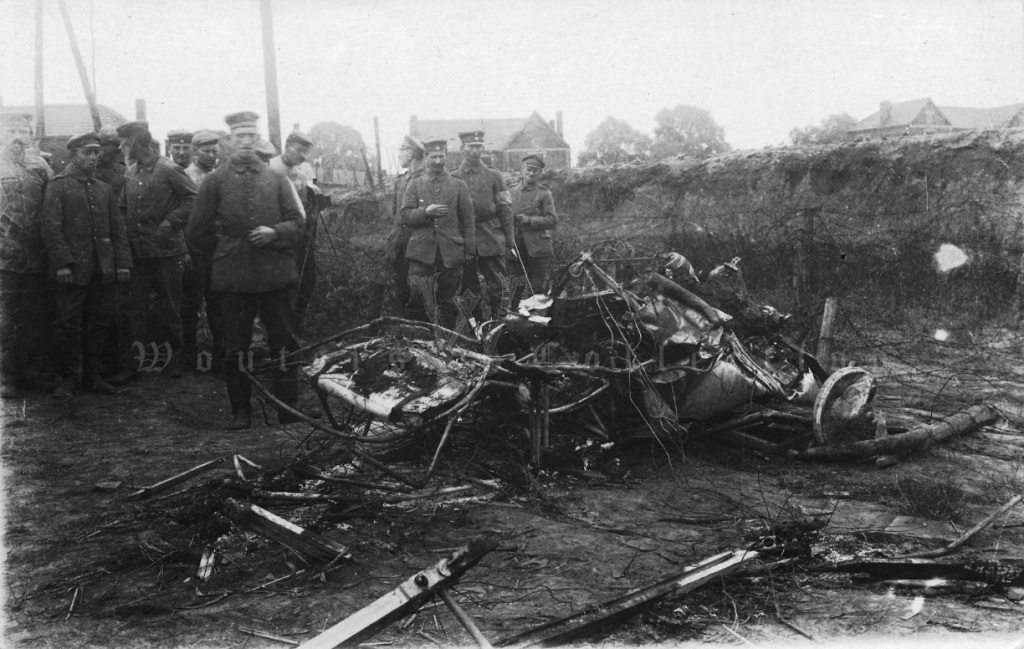| IMMELMANN FELL 6,000 FEET TO DEATH— Intrepid German Aviator Was Fighting Two Aeroplanes at the Same Time.— From a Staff Correspondent. Special Cable to THE NEW YORK TIMES.BERLIN, June 24.—The Lokal Anzeiger prints a field letter from an eyewitness of First Lieutenant Immelmann’s death flight. Lieutenant Immelmann had a record of fifteen enemy aeroplanes destroyed. “It was 9 in the evening,” says the letter, “when the rat-tat of aerial machine guns lured me out of my quarters, and I saw at a height of several thousand yards five aeroplanes in a hot fight; two Fokkers and three English and French biplanes. The tiny, swift Fokkers were like swallows in comparison with the big, lumbering but sure flying double-deckers. There was an increased liveliness aloft as the Fokkers overtook the biplanes and bore down on them with frightful speed. Amid a mad rattle of five machine guns our hearts stood still. Now the Fokkers have reached the enemy, but have turned themselves loose again. Then they pounce with fresh strength on the biplanes, now flying in confused circles. One of the Fokkers has singled out his prey and doesn’t leave him. While the big biplane only seeks to fly lower or higher, the Fokker cuts off the escape each time. Suddenly the big machine reels. “‘Hurrah; he’s hit!’ is roared from a thousand throats. I was watching closely, and noticed that the Fokker, too, was making curious tumbling motions, righting itself like an animal mortally wounded, then fluttering down, first slowly, then faster. A sudden jerk brings the machine again to a horizontal position. Thank God, I think, and breathe easier, when suddenly the Fokker overturns completely, the tail falls away, one of the wings flutters off, and, with an uncanny whistling sound, the machine precipitates from 6,000 feet earthward and strikes with a dull thud. “I ran as fast as possible to the spot. The motor had buried itself deep in the earth, [burying] the pilot under it. A crowd of soldiers quickly gathered. “‘It’s a Frenchman,’ say some. Another answers, ‘Unfortunately, it’s a German.’ But he gets threatening looks from the crowd. Meanwhile some of us have with great effort succeeded in turning over the motor, and several officers appear and supervise the examination of the dead. Is it an Englishman, Frenchman, or German? None knows for certain. “At last we have opened the leather coat. The first thing we see is the Pour le Merite decoration. Immelmann or Boelcke? An anxious silence fell on all standing around. Then we found the Iron Cross and then the monogram ‘MI’ on the shirt. “‘Our poor Immelmann!’ said a high officer present, and sadly we repeated it.” The Tägliche Rundschau also prints a letter from an eyewitness: “Immelmann didn’t make it easy for his enemies,” says the letter. “He had already shot down three enemy fliers, and at the time of his death plunge he was engaged in a fight with two enemy machines. While he was pursuing and firing at the one his Fokker was hit by the other. Probably a steel truss was broken, but Immelmann had bitten himself so firmly into his enemy that he didn’t notice it. He continued to pursue his victim until suddenly the tail broke off, and Immelmann and his rudderless Fokker plunged to his death. His half-annihilated enemy was then brought down by Immelmann’s comrades, also in Fokkers.”The New York Times (New York, N.Y.), Sunday, June 25, 1916 | ||

